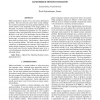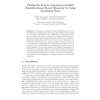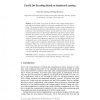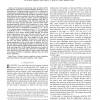ICRA
2009
IEEE
14 years 26 days ago
2009
IEEE
Although RANSAC is the most widely used robust estimator in computer vision, it has certain limitations making it ineffective in some situations, such as the motion estimation prob...
ICMCS
2009
IEEE
14 years 27 days ago
2009
IEEE
In the H.264/AVC coding standard, motion estimation (ME) is allowed to use multiple reference frames to make full use of reducing temporal redundancy in a video sequence. Although...
ICIP
2010
IEEE
14 years 1 months ago
2010
IEEE
Motion estimation is known to be a non-convex optimization problem. This non-convexity comes from several ambiguities in motion estimation such as the aperture problem, or fast mo...
RAS
2010
14 years 1 months ago
2010
In this paper, we present a method that allows us to recover the trajectory of a vehicle purely from monocular omnidirectional images very accurately. The method uses a combination...
PCM
2010
Springer
14 years 1 months ago
2010
Springer
Abstract. In this paper, we propose an efficient video coding system that applies statistical learning methods to reduce the computational cost in H.264 encoder. The proposed metho...
IAJIT
2010
14 years 1 months ago
2010
: The coding gain of the H.264/AVC video encoder mainly comes from the new incorporated prediction tools. However, their enormous computation and ultrahigh memory bandwidth are the...
PAMI
2007
14 years 2 months ago
2007
—We present a novel space-time patch-based method for image sequence restoration. We propose an adaptive statistical estimation framework based on the local analysis of the bias-...
TIP
1998
14 years 2 months ago
1998
—We propose novel discrete cosine transform (DCT) pseudophase techniques to estimate shift/delay between two onedimensional (1-D) signals directly from their DCT coefficients by...
PAMI
2000
14 years 2 months ago
2000
JEI
2000
14 years 2 months ago
2000
Motion estimation is a temporal image compression technique, where an n x n block of pixels in the current frame of a video sequence is represented by a motion vector with respect...




